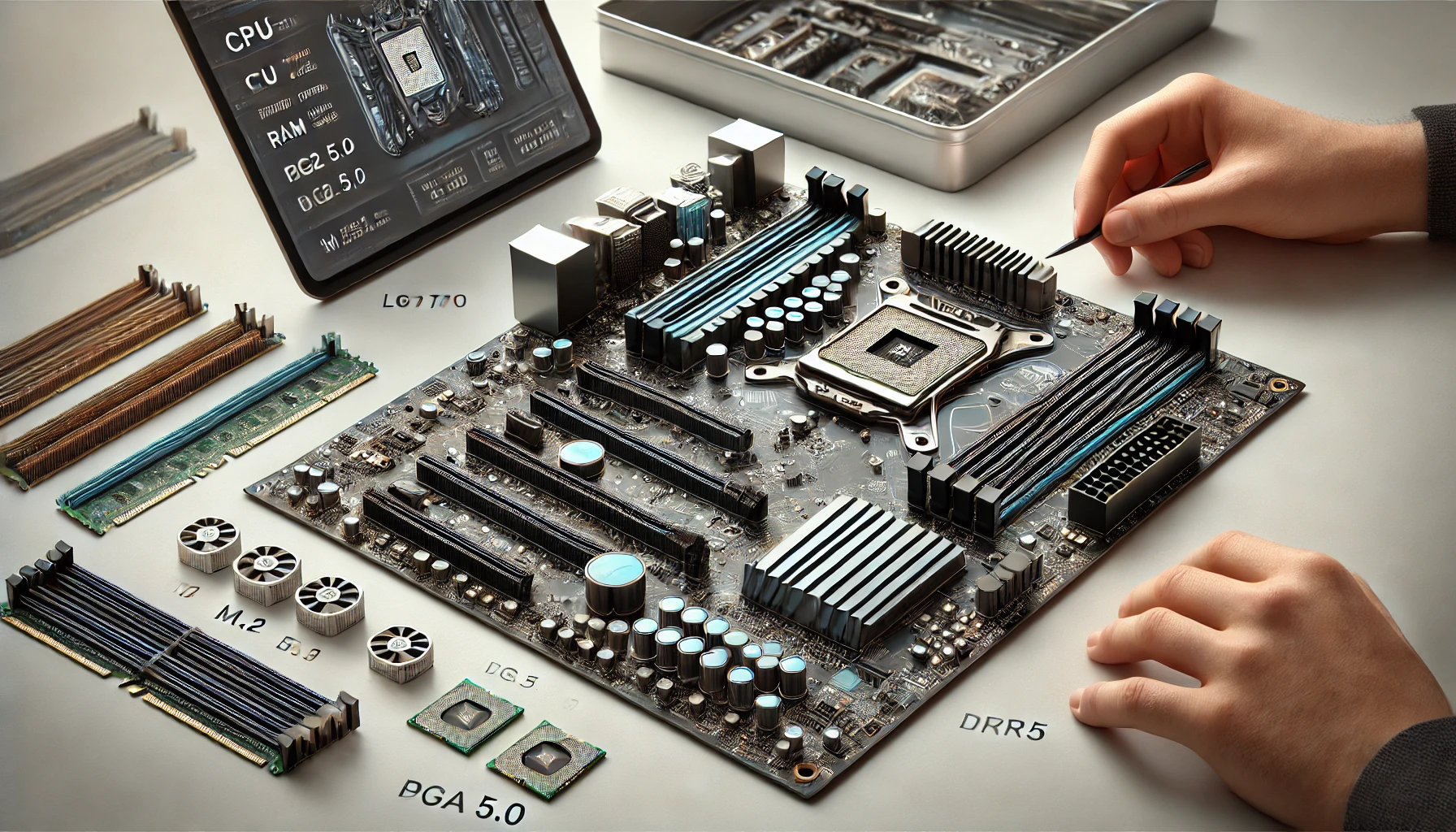When building or upgrading a PC, the motherboard is one of the most critical decisions you’ll make. It’s the central hub that connects all components—CPU, RAM, GPU, storage, and more. Choosing the wrong motherboard can limit performance, future upgrades, or even make components incompatible.
In this guide, you’ll learn how to choose the ideal motherboard in 2025 based on your goals, budget, and system requirements.
What Is a Motherboard and Why It Matters
The motherboard is the main circuit board in your PC that holds and connects essential components. It manages communication between your CPU, RAM, graphics card, storage drives, cooling, power supply, and more.
It also determines:
- What CPUs you can use
- The type and speed of RAM supported
- How many expansion slots and ports are available
- Whether your system supports overclocking or PCIe 5.0
- Connectivity options like Wi-Fi 6E, Bluetooth, USB-C, etc.
Your choice will impact your build’s functionality and upgrade potential—so let’s break it down.
Step 1: Choose the Right CPU First
Motherboards are built for specific CPU brands and socket types. So, choose your processor first, then find a compatible motherboard.
In 2025, most PC builders are choosing between:
Intel
- 13th/14th Gen (LGA 1700): Still widely available, budget-friendly
- 15th Gen (LGA 1851): Latest generation with DDR5 and PCIe 5.0 support
AMD
- Ryzen 5000 (AM4): Great for budget and mid-range builds
- Ryzen 7000/8000 (AM5): Latest-gen with full DDR5, PCIe 5.0, and USB4 support
💡 Your motherboard must match the CPU socket and chipset family.
Step 2: Select the Correct Form Factor
Motherboards come in various sizes. Choose one based on your PC case size and connectivity needs.
| Form Factor | Description | Ideal For |
|---|---|---|
| ATX | Standard size, most expansion options | Gaming and workstation builds |
| Micro-ATX | Smaller, fewer slots | Budget or compact setups |
| Mini-ITX | Very compact, limited features | Small form factor PCs |
💡 Always check your PC case’s supported form factors.
Step 3: Understand Chipset Differences
The chipset determines the motherboard’s features and capabilities.
Intel 2025 Chipsets (LGA 1851):
- Z890 – Premium features, full overclocking
- B860 – Mid-range, no CPU overclocking
- H810 – Basic, budget builds
AMD 2025 Chipsets (AM5):
- X770/X870 – Enthusiast-grade with PCIe 5.0, USB4, overclocking
- B650/B750 – Mid-range, most features without high cost
- A620 – Entry-level, limited expansion and features
If you’re overclocking or using high-end GPUs/SSDs, choose a high-tier chipset. Otherwise, mid-range options offer the best value.
Step 4: RAM Compatibility
Motherboards support either DDR4 or DDR5 RAM—not both. In 2025, most newer motherboards support DDR5, but DDR4 is still viable for budget builds.
Check:
- RAM type (DDR4 or DDR5)
- Maximum capacity (e.g., 64GB, 128GB)
- Number of RAM slots (2 or 4)
- Supported frequencies (e.g., 5200MHz, 6400MHz)
💡 Enable XMP (Intel) or EXPO (AMD) in BIOS to run RAM at full speed.
Step 5: PCIe and Expansion Slot Support
Modern GPUs and NVMe SSDs rely on PCIe lanes. In 2025, PCIe 5.0 is the standard for high-end builds.
- Look for PCIe x16 slot for your graphics card
- Check for PCIe 4.0/5.0 M.2 slots for SSDs
- Additional x1/x4 slots are useful for Wi-Fi, capture cards, etc.
💡 PCIe 5.0 is only useful if you’re using Gen 5 GPUs or SSDs—otherwise, PCIe 4.0 is still excellent.
Step 6: Storage Options
Modern motherboards support multiple storage formats:
- M.2 NVMe SSD slots (PCIe 4.0 or 5.0) – fastest storage option
- SATA ports – for SSDs and HDDs
- Look for the number of M.2 slots if you want multiple high-speed drives
💡 Some motherboards have integrated heatsinks for M.2 drives—great for keeping them cool.
Step 7: Connectivity and Rear I/O
This is where many builders overlook value. Modern motherboards can include:
- USB 3.2 / USB 4 / USB-C ports
- 2.5G or 10G LAN
- Wi-Fi 6E or Wi-Fi 7 + Bluetooth 5.3
- HDMI/DisplayPort (if using integrated graphics)
- Audio jacks (Realtek ALC1220 or better)
💡 Make sure the board includes all the connections your case and devices require.
Step 8: BIOS Features and Ease of Use
Look for motherboards that offer:
- EZ Flash or Q-Flash: easy BIOS updates via USB
- Debug LEDs or Q-Codes: help troubleshoot problems
- User-friendly UEFI interface: easier navigation
- Clear CMOS / BIOS Flashback buttons: reset or update BIOS easily
These small features can make your build and maintenance experience much smoother.
Step 9: Build Quality and VRM Cooling
A motherboard’s power delivery affects stability—especially with high-end CPUs or overclocking.
- Look for 12+ phase VRMs for performance CPUs
- Check for heatsinks on VRMs to prevent overheating
- Avoid ultra-budget boards if you’re running a powerful processor
💡 Good VRM cooling ensures long-term stability and CPU performance.
Step 10: Budget and Future-Proofing
Motherboard pricing in 2025:
| Range | Price (USD) | Best For |
|---|---|---|
| Entry-level | $80–$120 | Office or budget builds |
| Mid-range | $130–$200 | Gaming and streaming |
| High-end | $200–$400+ | Workstations, overclocking, heavy multitasking |
Future-proofing tips:
- Choose DDR5 and PCIe 5.0 support if you’re planning to upgrade in the next 2–3 years
- Ensure USB4 or Thunderbolt support if needed for peripherals
- Get Wi-Fi 6E or 7 built-in if you’re not using Ethernet
Final Thoughts
The motherboard you choose defines the backbone of your PC. It determines what components you can use, how easily you can upgrade, and whether your system performs at its full potential. By matching your CPU, RAM, and connectivity needs to the right chipset and form factor, you can build a system that’s fast, stable, and ready for the future.
Always check compatibility twice, read reviews, and invest in quality—because a good motherboard supports everything else you build on top of it.
